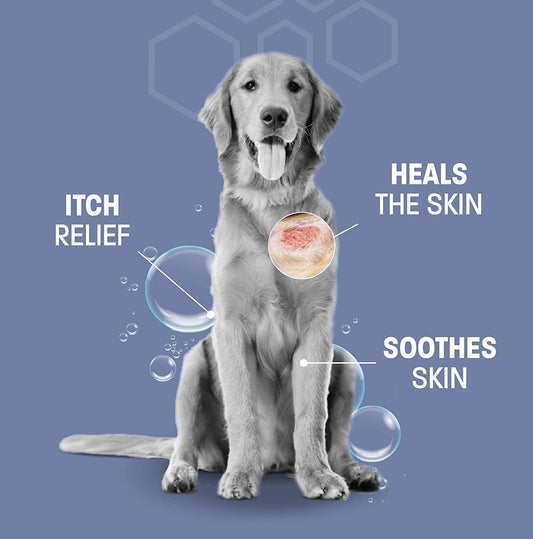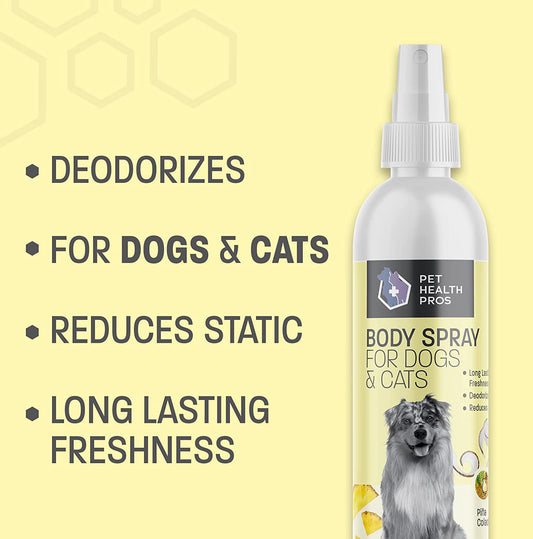Dog chewing can be a frustrating and destructive behavior. Whether it's furniture, shoes, or household items, dogs have a natural instinct to chew. In this article, we will explore the reasons behind dog chewing, the dangers it poses, and how to effectively prevent it using the best repellents. We will also provide key takeaways to help you understand and address this behavior.
Key Takeaways
- Understanding why dogs chew is essential for effective prevention.
- Choosing the right dog repellent involves considering factors like safety and effectiveness.
- There are different types of dog repellents available, including natural alternatives to chemical options.
- Identifying problem areas in your home and applying repellents correctly are crucial for success.
- Providing appropriate chew toys and mental stimulation can redirect your dog's chewing behavior.
Understanding Dog Chewing Behavior
Why do dogs chew?
Chewing is a natural behavior for dogs and serves several purposes. Chewing helps to keep their teeth clean and healthy by removing plaque and tartar buildup. It also helps to exercise their jaw muscles and relieve boredom or anxiety. Dogs may chew on objects to explore their environment and alleviate teething discomfort. Additionally, chewing can be a way for dogs to release excess energy. It is important to provide appropriate chew toys to satisfy their chewing needs and prevent them from chewing on inappropriate items.
Common objects dogs chew on
Dogs have a natural instinct to chew, and they often target common objects in our homes. Some of the most common objects that dogs chew on include furniture, shoes, clothing, electrical cords, and household items. Chewing on these objects can be a result of teething, boredom, anxiety, or a way for dogs to explore their environment. It's important to understand why dogs chew on these objects so that we can take appropriate measures to prevent it.
The dangers of dog chewing
Dog chewing can pose several dangers to both the dog and the household. One of the main dangers is the risk of injury. Dogs that chew on inappropriate objects may accidentally swallow small pieces, which can lead to choking or intestinal blockage. Ingesting toxic substances is another danger of dog chewing. Many household items, such as cleaning products, medications, and certain plants, can be toxic to dogs if ingested. Additionally, dog chewing can cause damage to furniture, electrical cords, and other valuable items, resulting in costly repairs or replacements.
Choosing the Right Dog Repellent
Factors to consider when selecting a dog repellent
When selecting a dog repellent, there are several important factors to consider. Effectiveness is one of the key factors to look for. You want a repellent that is proven to deter dogs from chewing on objects. Look for products that have positive reviews and testimonials from other dog owners.
Another factor to consider is safety. You want a repellent that is safe for both your dog and your household. Avoid repellents that contain harmful chemicals or ingredients that could be toxic to dogs.
Ease of use is also an important factor to consider. Look for repellents that are easy to apply and require minimal effort. Some repellents come in spray form, while others come in granules or gel form. Choose a repellent that fits your preferences and lifestyle.
Lastly, consider the longevity of the repellent. You want a product that will provide long-lasting protection against dog chewing. Look for repellents that have a long shelf life and can withstand various weather conditions.
Types of dog repellents
When it comes to choosing the right dog repellent, there are several options available. Sprays are a popular choice as they can be easily applied to various surfaces. These sprays usually contain a bitter agent that dogs find unpleasant, discouraging them from chewing on objects. Another option is ultrasonic devices, which emit high-frequency sounds that are unpleasant to dogs but inaudible to humans. These devices can be placed in problem areas to deter dogs from chewing. Physical barriers such as fences or gates can also be effective in keeping dogs away from certain areas.
Natural alternatives to chemical repellents
When it comes to keeping dogs away from certain areas or objects, there are natural alternatives to chemical repellents that can be effective. These alternatives are not only safer for your dog, but also for the environment. One option is to use citrus scents, such as lemon or orange, as dogs tend to dislike these smells. You can place citrus peels or essential oils in the areas you want to protect. Another natural repellent is vinegar, which can be sprayed on objects or surfaces to deter dogs from chewing. However, it's important to note that vinegar should be used sparingly and not on delicate materials.
Using Dog Repellents Effectively
Identifying problem areas in your home
When it comes to preventing dog chewing, one of the first steps is to identify problem areas in your home. These are the areas where your dog is most likely to engage in destructive chewing behavior. Common problem areas include furniture, shoes, electrical cords, and trash cans. By identifying these areas, you can take proactive measures to protect your belongings and keep your dog safe.
Applying dog repellents correctly
When applying dog repellents, it is important to follow the instructions carefully to ensure their effectiveness. Here are some tips to help you apply dog repellents correctly:
-
Choose the right repellent: There are different types of dog repellents available, including sprays, powders, and ultrasonic devices. Consider the specific needs of your dog and the area you want to protect when selecting a repellent.
-
Identify problem areas: Before applying the repellent, identify the areas where your dog is prone to chewing. This could be furniture, shoes, or specific rooms in your home.
-
Clean and prepare the surfaces: Make sure to clean the surfaces thoroughly before applying the repellent. Remove any traces of previous chewing or scent markings to ensure the repellent works effectively.
-
Apply evenly: Apply the repellent evenly on the surfaces you want to protect. Follow the instructions on the product label for the recommended amount to use.
-
Reapply as needed: Dog repellents may need to be reapplied periodically, especially if they are exposed to rain or frequent cleaning. Check the product label for guidance on reapplication frequency.
Remember, consistency is key when using dog repellents. By applying them correctly, you can help deter your dog from chewing on inappropriate items and create a more harmonious living environment.
Training your dog to avoid chewable items
Training your dog to avoid chewable items is an essential part of preventing destructive chewing behavior. Here are some tips to help you train your dog:
-
Provide appropriate chew toys: Make sure your dog has plenty of chew toys that are specifically designed for dogs. These toys should be durable and safe for your dog to chew on.
-
Use positive reinforcement: When you catch your dog chewing on something they shouldn't, redirect their attention to a chew toy and praise them when they chew on it instead. This will help them associate chewing on the appropriate items with positive rewards.
-
Be consistent: Consistency is key when training your dog. Make sure everyone in your household is on the same page and follows the same rules when it comes to preventing chewing on inappropriate items.
-
Use deterrents: In addition to providing chew toys, you can also use deterrents to discourage your dog from chewing on certain items. Bitter sprays or anti-chewing sprays can be applied to objects that you want to protect from your dog's chewing.
Remember, training takes time and patience. With consistent training and the right tools, you can help your dog develop good chewing habits and prevent destructive chewing behavior.
Additional Tips for Preventing Dog Chewing
Providing appropriate chew toys
When it comes to preventing dog chewing, providing appropriate chew toys is essential. Chew toys serve as a great alternative to your dog's destructive chewing behavior. These toys are specifically designed to satisfy your dog's natural urge to chew while keeping them engaged and entertained.
To ensure you choose the right chew toys for your dog, consider the following:
- Durability: Look for chew toys that are made from durable materials, such as rubber or nylon, to withstand your dog's strong chewing.
- Size: Select chew toys that are appropriate for your dog's size to prevent any choking hazards.
- Texture: Dogs have different preferences when it comes to the texture of their chew toys. Experiment with different textures, such as soft or textured, to find what your dog enjoys the most.
Remember, it's important to regularly inspect and replace chew toys that show signs of wear and tear to ensure your dog's safety. By providing appropriate chew toys, you can redirect your dog's chewing behavior and protect your belongings.
Keeping your dog mentally stimulated
Keeping your dog mentally stimulated is just as important as providing physical exercise. Mental stimulation helps prevent boredom and can reduce the likelihood of destructive chewing behavior. Here are some ways to keep your dog's mind engaged:
-
Puzzle toys: These toys require your dog to problem-solve and work for their treats. They can provide hours of entertainment and mental stimulation.
-
Training sessions: Regular training sessions not only teach your dog new skills but also challenge their brain. Use positive reinforcement techniques to make the sessions fun and rewarding.
-
Interactive games: Play interactive games with your dog, such as hide-and-seek or treasure hunts. These games engage their senses and keep them mentally active.
-
Rotating toys: Keep your dog's toy collection fresh by rotating toys every few days. This prevents boredom and maintains their interest in their toys.
Remember, a mentally stimulated dog is a happy and well-behaved dog!
Seeking professional help if necessary
If your dog's chewing behavior persists despite your best efforts, it may be time to seek professional help. A qualified dog trainer or behaviorist can assess the underlying causes of your dog's chewing and provide guidance on how to address the issue effectively.
They can help you develop a customized training plan tailored to your dog's specific needs. This may involve teaching alternative behaviors, such as appropriate chewing on designated toys, and implementing positive reinforcement techniques.
Remember, seeking professional help is not a sign of failure but a proactive step towards resolving the issue and ensuring your dog's well-being.
Preventing dog chewing can be a challenging task for pet owners. Dogs have a natural instinct to chew, and if not properly managed, they can cause damage to furniture, shoes, and other household items. To help prevent dog chewing, it is important to provide them with appropriate chew toys and bones. Regular exercise and mental stimulation can also help reduce their urge to chew. Additionally, using deterrent sprays or bitter-tasting substances on items that are off-limits can discourage dogs from chewing. Training and positive reinforcement techniques can also be effective in teaching dogs what they are allowed to chew on. If you're struggling with dog chewing, Pet Health Pros can help. Visit our website for a wide range of affordable and top-grade pet health supplies. Our products are made in the USA and backed by a 100% satisfaction guarantee, so you can shop with confidence.
Conclusion
In conclusion, using the best repellent is an effective way to prevent dog chewing. By detering dogs from chewing on furniture, shoes, and other household items, you can protect your belongings and create a safe environment for your furry friend. Remember to choose a repellent that is safe for dogs and easy to use. With the right repellent, you can say goodbye to dog chewing and enjoy a harmonious relationship with your pet.
Frequently Asked Questions
How do I stop my dog from chewing on furniture?
To stop your dog from chewing on furniture, you can try using a bitter apple spray or a pet-safe deterrent. Additionally, providing your dog with appropriate chew toys and ensuring they get enough mental and physical exercise can help redirect their chewing behavior.
Are there any natural alternatives to chemical dog repellents?
Yes, there are natural alternatives to chemical dog repellents. Some options include using citrus peels, vinegar, or cayenne pepper as deterrents. However, it's important to note that natural repellents may not be as effective as chemical ones and may need to be reapplied more frequently.
Can I use dog repellents on outdoor furniture?
Yes, you can use dog repellents on outdoor furniture. There are specifically formulated repellents available that are safe to use on outdoor surfaces. Make sure to read the instructions and choose a repellent that is suitable for outdoor use.
What are some common objects that dogs chew on?
Dogs commonly chew on items such as shoes, furniture, electrical cords, and household objects. It's important to provide your dog with appropriate chew toys to redirect their chewing behavior onto acceptable items.
How long does it take to train a dog to stop chewing?
The time it takes to train a dog to stop chewing can vary depending on the individual dog and the consistency of training. It may take a few weeks to several months to see significant improvement. Consistency, positive reinforcement, and providing alternative chew toys are key in the training process.
What should I do if my dog continues to chew despite using repellents?
If your dog continues to chew despite using repellents, it may be helpful to consult with a professional dog trainer or behaviorist. They can assess the underlying reasons for the chewing behavior and provide guidance on how to address it effectively.









